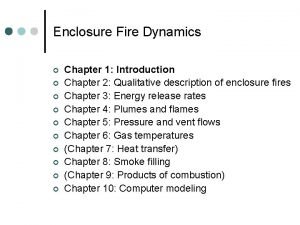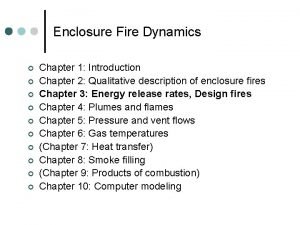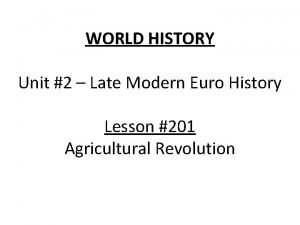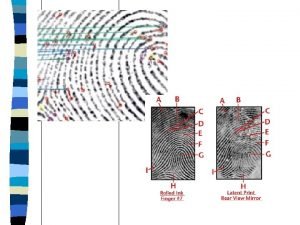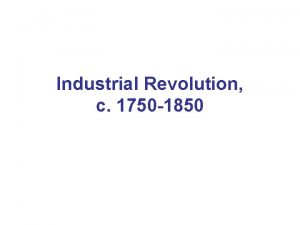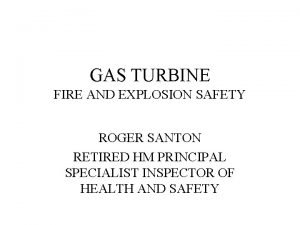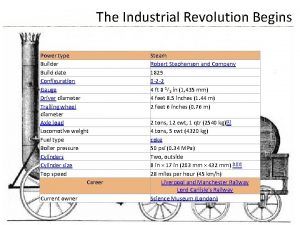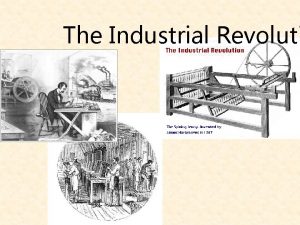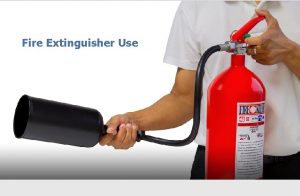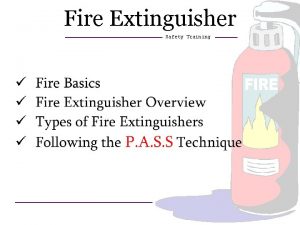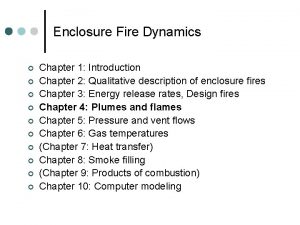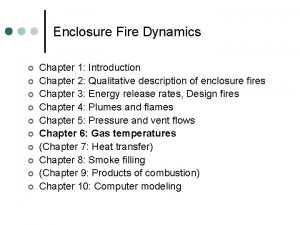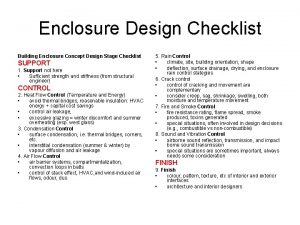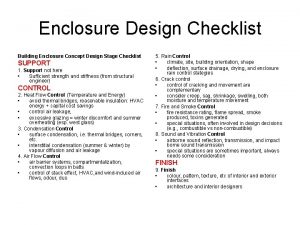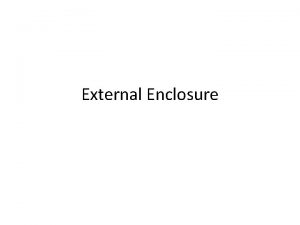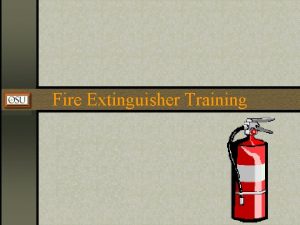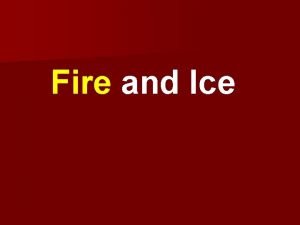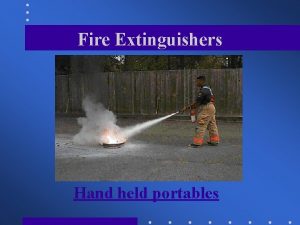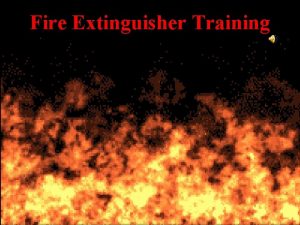Enclosure Fire Dynamics Chapter 1 Introduction Chapter 2





![Background information on flows in buildings Pascal [Pa] = force of 1 Newton [N] Background information on flows in buildings Pascal [Pa] = force of 1 Newton [N]](https://slidetodoc.com/presentation_image_h/78ab0c003dc692e33ca874e522be6655/image-6.jpg)































- Slides: 37

Enclosure Fire Dynamics ¢ ¢ ¢ ¢ ¢ Chapter 1: Introduction Chapter 2: Qualitative description of enclosure fires Chapter 3: Energy release rates, Design fires Chapter 4: Plumes and flames Chapter 5: Pressure and vent flows Chapter 6: Gas temperatures (Chapter 7: Heat transfer) Chapter 8: Smoke filling (Chapter 9: Products of combustion) Chapter 10: Computer modeling

Overview Background on fluid flow ¢ Bernoulli equation ¢ Flow through vents from well mixed compartments ¢ Flow through vents from stratified compartments ¢ Flow though ceiling vents ¢

What causes the flow of gases in a building? ¢ Flows driven by fire Expansion due to heating l Pressure differences caused by buoyancy l ¢ Flows driven not by fire Pressure differences caused by temperature variations throughout a building l Atmospheric conditions (wind against a building) l Mechanical ventilation (fans, heating system) l

Thermal expansion

Fluid flows generated by fire
![Background information on flows in buildings Pascal Pa force of 1 Newton N Background information on flows in buildings Pascal [Pa] = force of 1 Newton [N]](https://slidetodoc.com/presentation_image_h/78ab0c003dc692e33ca874e522be6655/image-6.jpg)
Background information on flows in buildings Pascal [Pa] = force of 1 Newton [N] acting over an area of 1 m 2 ¢ At sea level, normal atmospheric pressure is 101 300 Pa ¢ Pressure differences in buildings due to fire: ¢ Small fraction of atmospheric pressure l << 100 Pa l Usually only a few Pa l

Relating density and temperature ¢ Start with ideal gas law ¢ For properties of air l T in [K] in [kg/m 3]

Types of pressure ¢ Hydrostatic pressure l ¢ Hydrodynamic pressure l ¢ Due to fluid at rest Due to fluid in motion For a compartment fire l Hydrostatic pressure will be converted into hydrodynamic pressures • Fluid flows from high pressure to low pressure • Produces flow through vent

Pressure differences produced by fluids ¢ Hydrostatic pressure is a function of fluid density

Pressures generated in buildings

Bernoulli ¢ Remember your friend - the Bernoulli equation… ¢ Static pressure head ¢ Hydrodynamic pressure term ¢ Hydrostatic pressure term

A simple example for using the Bernoulli equation

Pressures generated in buildings ¢ Temperature inside building is warmer than temperatures outside building l Only small openings at top and bottom of building

Example – Flow through opening

Bernoulli equation example for flows at the lower vent

Fluid flow is restricted when passing through an opening ¢ For vents in buildings, we usually use 0. 6 < Cd < 0. 7

Mass flow through vents ¢ If pressure difference is constant over vent height, then the velocity is also constant l Narrow vents ¢ Discharge (flow) coefficient, Cd, accounts for edge effects ¢ When velocity is not constant, it is necessary to integrate over profile to arrive at mass flow rate

For the small openings in a building ¢ Mass flow out the upper vent ¢ Mass flow in the lower vent

What is the neutral plane height? Problem is we do not know hu and hl at this point ¢ Use conservation of mass to derive a relation for hu and hl ¢ l Flow in must equal flow out

Neutral plane

Neutral plane

Vent flows and the neutral plane

Pressure profiles for a room with a vent Consider a compartment with a large opening ¢ Pressure difference and velocity will vary over the cross section of the opening ¢ We will look at 4 different cases that occur during the development of the fire ¢

Stage C Stratified case Air flowing into compartment in lower level ¢ Formation of neutral plane ¢

Stage D Well mixed case Hot smoke layer extends to the floor ¢ Post-flashover ¢ l Can also apply to a small fire in a well mixed room

Begin with the equations for the well mixed case Assume a large opening ¢ Mass flow rate in equals the mass flow rate out ¢ l ¢ Mass of the fire is assumed very small Uniform temperature throughout the compartment

Flow from a well mixed compartment ¢ ¢ Velocity is a maximum where the pressure difference is greatest Since the pressure difference (and velocity) is a function of height, it is necessary to integrate over the height, z

Integrating over the opening height ¢ Mass flow rate through vent ¢ Velocity is assumed constant across the width of the opening l ¢ ¢ It only changes with height Integrate above the neutral plane for flow out the compartment Integrate below the neutral plane for flow into the compartment

Final form of the equations ¢ Flow out of the compartment ¢ Flow into the compartment ¢ Expressions for neutral plane height

A simplified form is available ¢ Assume ambient properties ¢ Accurate when temperatures are over 300 o. C and hot gases are uniformly distributed throughout compartment

Mass flow rate through a ceiling vent ¢ ¢ Mass flow in assumed equal to mass flow out Pressure difference across top vent is constant

Pressure differencestack effect

Normal stack effect ¢ Air inside the building warmer than outside l ¢ Winter Greater pressure differences Taller spaces l Larger temperature difference l

Reverse stack effect ¢ Air inside the building cooler than outside l ¢ Air-conditioned If the smoke is hot enough, it may overcome reverse stack effect

Pressure differences - wind effect

Additional reading material SFPE Handbook Sec 2/Ch 5, Sec 3/Ch 9 ¢ Design of Smoke Management Systems by Klote and Milkie ¢

Any questions?
 Enclosure fire dynamics
Enclosure fire dynamics Smoke exhaust
Smoke exhaust Enclosure fire
Enclosure fire Reichstag fire who was the fire starter
Reichstag fire who was the fire starter Fire damper access
Fire damper access Fire hose reel signage standards
Fire hose reel signage standards A-e rwi
A-e rwi Fire extinguisher parts
Fire extinguisher parts Enclosure movement
Enclosure movement Enclosure movement industrial revolution
Enclosure movement industrial revolution Enclosure movement
Enclosure movement Enclosure movement
Enclosure movement Flower basics worksheet
Flower basics worksheet Ridges of fingerprint island
Ridges of fingerprint island Ridge characteristics of a fingerprint
Ridge characteristics of a fingerprint Enclosure notation on letter
Enclosure notation on letter Enclosure notation example
Enclosure notation example Long term impacts of the industrial revolution
Long term impacts of the industrial revolution Enclosure notation example
Enclosure notation example Smoke detection gas turbines
Smoke detection gas turbines Lake or enclosure fingerprint
Lake or enclosure fingerprint What is the line spacing after the dateline
What is the line spacing after the dateline Enclosure movement industrial revolution
Enclosure movement industrial revolution Enclosure movement definition industrial revolution
Enclosure movement definition industrial revolution Enclosure movement definition industrial revolution
Enclosure movement definition industrial revolution Native pcie enclosure management
Native pcie enclosure management Qconverge console
Qconverge console Plural form of memorandum
Plural form of memorandum Enclosure industrial revolution
Enclosure industrial revolution Biology tenth edition
Biology tenth edition Enclosure industrial revolution
Enclosure industrial revolution Who is this
Who is this Enclosure acts
Enclosure acts Introduction of group dynamics
Introduction of group dynamics Ordinary combustibles or fibrous materials
Ordinary combustibles or fibrous materials Fire extinguisher types
Fire extinguisher types Introduction of fire extinguisher
Introduction of fire extinguisher Nature and use of fire insurance
Nature and use of fire insurance
